Welcome to the comparing fractions calculator, where you can easily find out which is larger and which is smaller between two fractions. There is no limit to the form of fractions, which can be proper fractions, improper fractions or mixed fractions.
How to compare fractions?
We know that fraction refers to the fraction of a number to another number, or the ratio of an event to all events. Therefore, when comparing fractions, there are three main principles:
- When the denominator is the same, the numerator is larger, the fraction will be larger.
- When the numerator is the same, the larger of denominator, the smaller the fraction.
- When the denominators are different, you must reduction of fractions to a common denominator first. Then, compare them according to the principle of 1. Note that as the denominator changes, so does the numerator.
Both proper and improper fractions can be compared according to the above 3 principles.
How to compare mixed fractions?
If they are mixed fractions, first look at the whole numbers part. If the whole number is large, the mixed fraction will be large. If the whole numbers part is the same, remove the whole numbers part and compare according to the above principles. Or convert the mixed fractions into the improper fractions, then compare according to the above principles.
Of course, the situation we encounter may be more complicated, such as the comparison of mixed fractions, the comparison of fractions and whole numbers, the comparison of fractions and decimals, and so on. Therefore, in order to reduce the amount of calculation and improve work efficiency, we have developed this free online comparing fractions calculator, which can solve at least the following 12 questions:
- Comparison between proper fractions
- Comparison of proper fractions and improper fractions
- Comparison of proper fractions and mixed fractions
- Comparison of proper fractions and whole numbers
- Comparison of proper fractions and decimals
- Comparison of improper fractions
- Comparison of improper fractions and mixed fractions
- Comparison of improper fractions and whole numbers
- Comparison of improper fractions and decimals
- Comparison of mixed fractions
- Comparison of mixed fractions and whole numbers
- Comparison of mixed fractions and decimals
Here are some examples to see how they are calculated and how the comparing fractions calculator is used.
12 questions can be solved by comparing fractions calculator
1. Comparison between proper fractions
For example, Which one is greater, 13 or 15?
Use the comparing fractions calculator to calculate:
- Enter 1 into the numerator value 1 input box;
- Enter 3 into the denominator value 1 input box;
- Enter 1 into the numerator value 2 input box;
- Enter 5 into the denominator value 2 input box;
- Do not enter other input boxes, click calculate button.
As the picture shows, 13 is greater than 15.
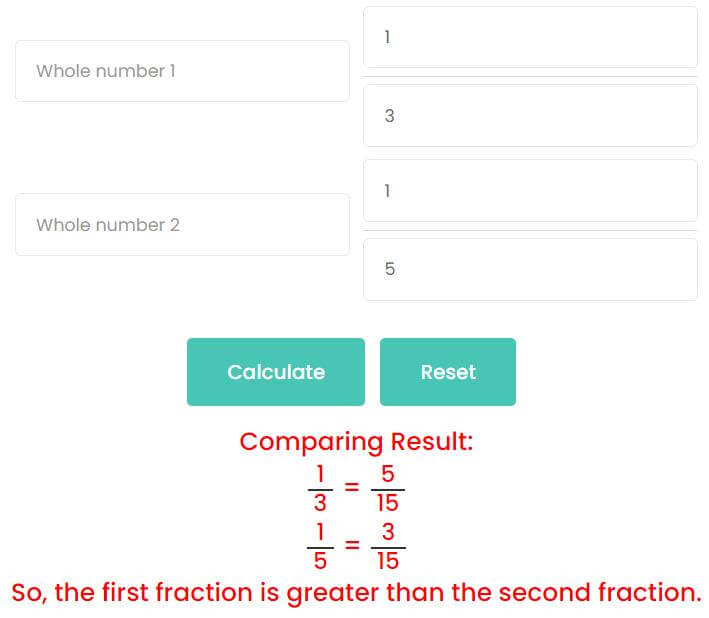
2. Comparison of proper fractions and improper fractions
For example, Compare 13 with 74
Use comparing fractions calculator to calculate:
- Enter 1 into the numerator value 1 input box;
- Enter 3 into the denominator value 1 input box;
- Enter 7 into the numerator value 2 input box;
- Enter 4 into the denominator value 2 input box;
- Do not enter other input boxes, click calculate button.
As the picture shows, 13 is less than 74.
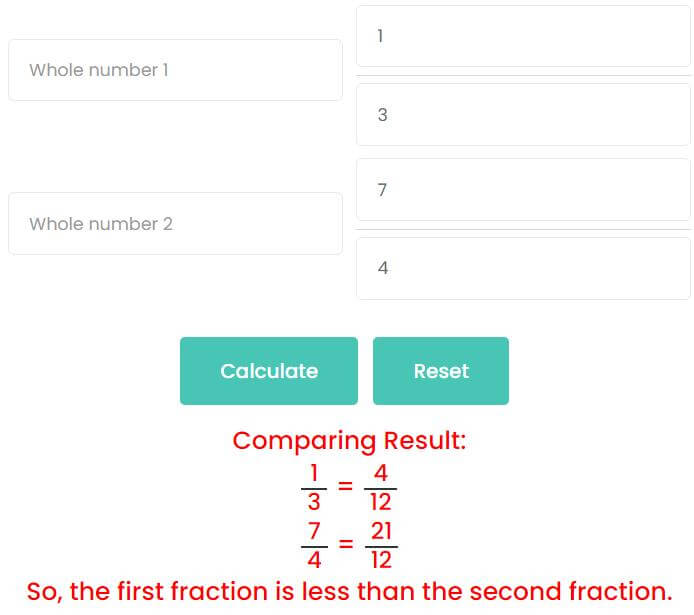
3. Comparison of proper fractions and mixed fractions
For example, Which one is greater, 12 or 518?
Use comparing fractions calculator to calculate:
- Enter 1 into the numerator value 1 input box;
- Enter 2 into the denominator value 1 input box;
- Enter 5 into the whole number 2 input box;
- Enter 1 into the numerator value 2 input box;
- Enter 8 into the denominator value 2 input box;
- Do not enter other input boxes, click calculate button.
As the picture shows, 12 is less than 518.
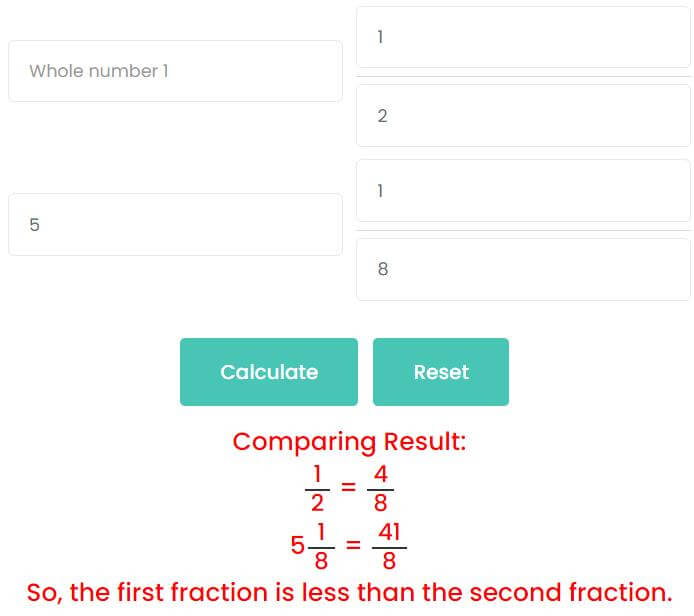
4. Comparison of proper fractions and whole numbers
For example, Which one is greater, 13 or 10?
Calculate with comparison calculator:
- Enter 1 into the numerator value 1 input box;
- Enter 3 into the denominator value 1 input box;
- Enter 10 into the whole number 2 input box;
- Do not enter other input boxes, click calculate button.
As the picture shows, 13 is less than 10.
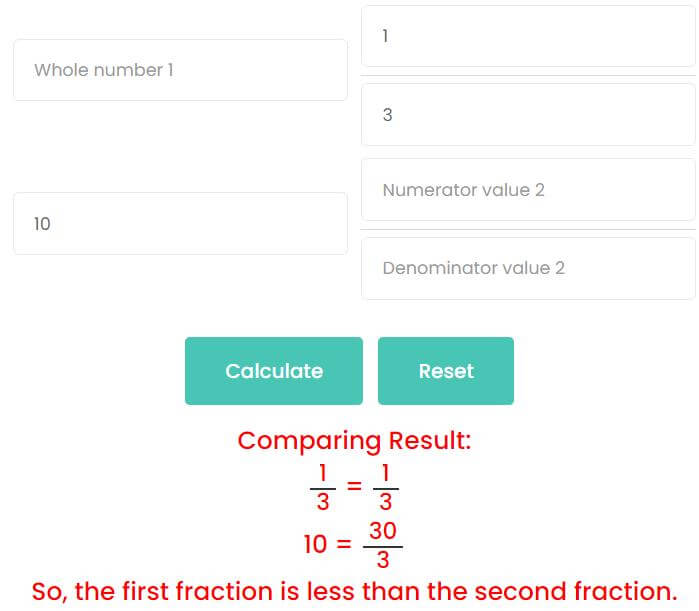
5. Comparison of proper fractions and decimals
For example, Compare 14 with 0.83
Calculate with comparison calculator:
- Enter 1 into the numerator value 1 input box;
- Enter 4 into the denominator value 1 input box;
- Enter 0.83 into the whole number 2 input box;
- Do not enter other input boxes, click calculate button.
As the picture shows, 14 is less than 0.83.

6. Comparison of improper fractions
For example, Which one is greater, 52 or 73?
Calculate with comparison calculator:
- Enter 5 into the numerator value 1 input box;
- Enter 2 into the denominator value 1 input box;
- Enter 7 into the numerator value 2 input box;
- Enter 3 into the denominator value 2 input box;
- Do not enter other input boxes, click calculate button.
As the picture shows, 52 is greater than 73.
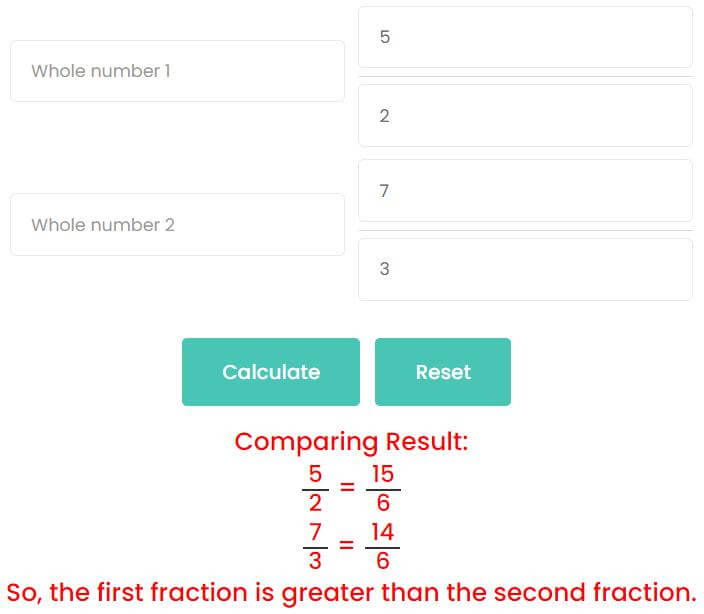
7. Comparison of improper fractions and mixed fractions
For example, Which one is greater, 83 or 635?
Use the calculator to calculate:
- Enter 8 into the numerator value 1 input box;
- Enter 3 into the denominator value 1 input box;
- Enter 6 into the whole number 2 input box;
- Enter 3 into the numerator value 2 input box;
- Enter 5 into the denominator value 2 input box;
- Do not enter other input boxes, click calculate button.
As the picture shows, 83 is less than 635.
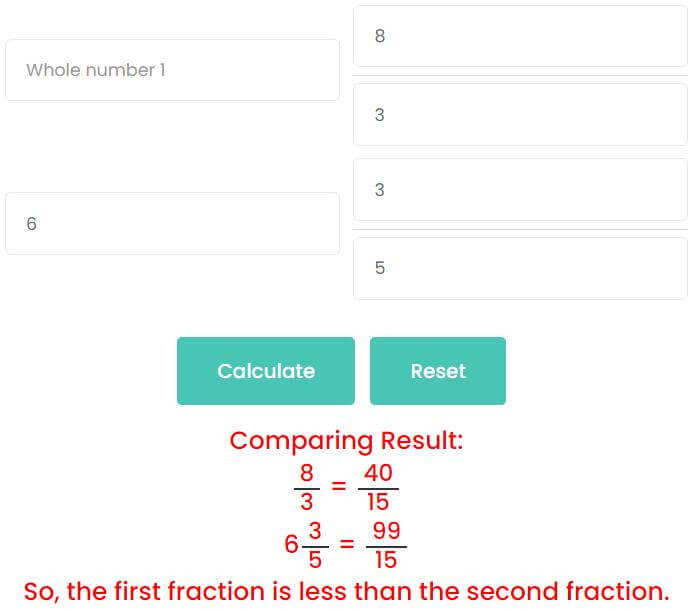
8. Comparison of improper fractions and whole numbers
For example, Which one is greater, 83 or 25?
Use the calculator to calculate:
- Enter 8 into the numerator value 1 input box;
- Enter 3 into the denominator value 1 input box;
- Enter 25 into the whole number 2 input box;
- Do not enter other input boxes, click calculate button.
As the picture shows, 83 is less than 25.
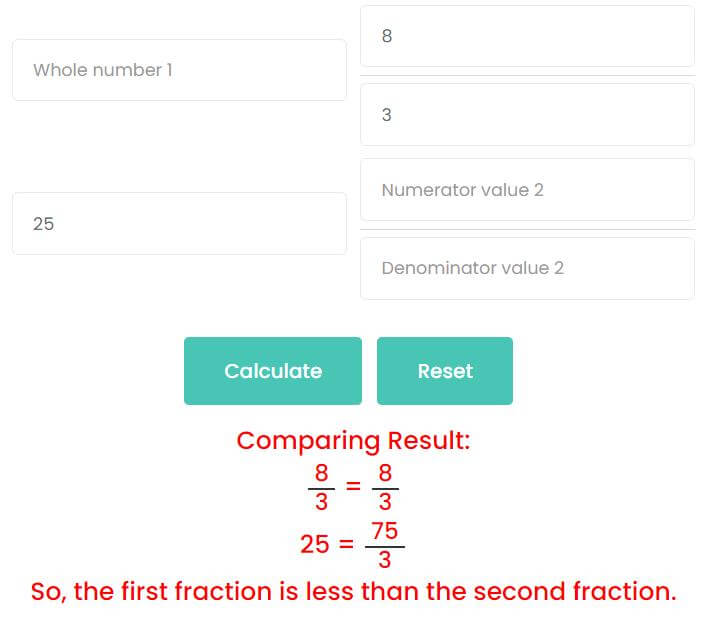
9. Comparison of improper fractions and decimals
For example, Which one is greater, 156 or 1.25?
Use the calculator to calculate:
- Enter 15 into the numerator value 1 input box;
- Enter 6 into the denominator value 1 input box;
- Enter 1.25 into the whole number 2 input box;
- Do not enter other input boxes, click calculate button.
As the picture shows, 156 is greater than 1.25.

10. Comparison of mixed fractions
For example, Compare 225 with 918
Use the calculator to calculate:
- Enter 2 into the whole number 1 input box;
- Enter 2 into the numerator value 1 input box;
- Enter 5 into the denominator value 1 input box;
- Enter 9 into the whole number 2 input box;
- Enter 1 into the numerator value 2 input box;
- Enter 8 into the denominator value 2 input box;
- Finally, click calculate button.
As the picture shows, 225 is less than 918.
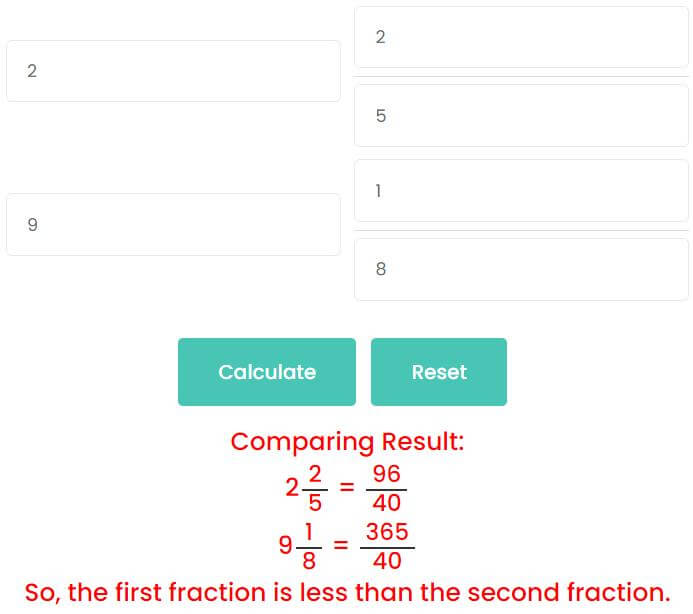
11. Comparison of mixed fractions and whole numbers
For example, Which one is greater, 519 or 30?
Use the calculator to calculate:
- Enter 5 into the whole number 1 input box;
- Enter 1 into the numerator value 1 input box;
- Enter 9 into the denominator value 1 input box;
- Enter 30 into the whole number 2 input box;
- Do not enter other input boxes, click calculate button.
As the picture shows, 519 is less than 30.
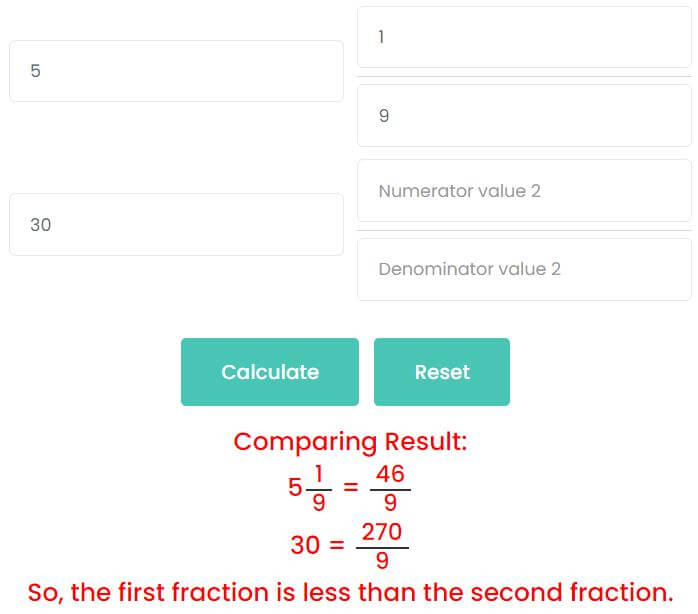
12. Comparison of mixed fractions and decimals
For example, Which one is greater, 425 or 5.96?
Use the calculator to calculate:
- Enter 4 into the whole number 1 input box;
- Enter 2 into the numerator value 1 input box;
- Enter 5 into the denominator value 1 input box;
- Enter 5.96 into the whole number 2 input box;
- Do not enter other input boxes, click calculate button.
As the picture shows, 425 is less than 5.96.
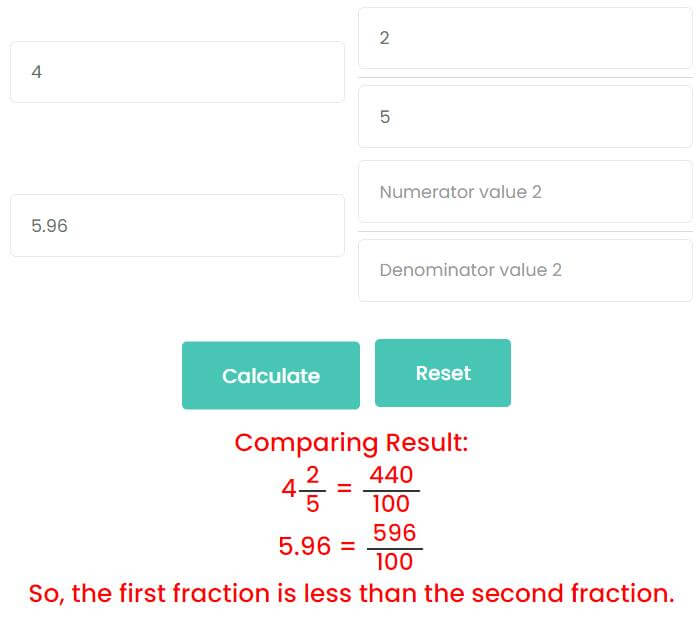
Latest calculators
Standard Form to Slope-Intercept Form Calculator
Slope Intercept Form Calculator
Slope Calculator: Calculate Slope, X-Intercept, Y-Intercept
Reciprocal of Complex Number Calculator
Conjugate Complex Number Calculator
Modulus of Complex Number Calculator
Profit Percentage Calculator: Calculate Your Profitability Easily
Attendance and Absence Percentage Calculator
Circular Segment Radius Calculator
Regular Polygon Side Length Calculator
Annulus Calculator for Width, Perimeter, and Area